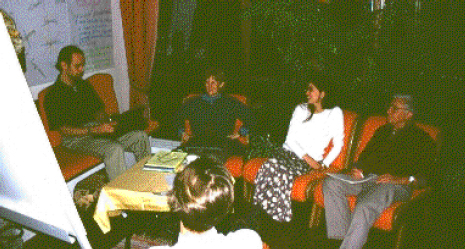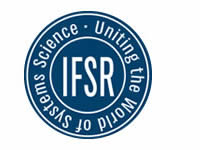IFSR Newsletter 1998 Vol. 17 No. 2 June

Sue McCormick, Charles François, Evolutionary Learning Communities, Kathia Laszlo, Alexander Laszlo, Bence Nanay, Fuschl Conversation 1998, IFSR Newsletter 1998 Vol 17 No 2 June
Sue McCormick, Charles François, Kathia Laszlo, Alexander Laszlo, Bence Nanay
The focus of the line of inquiry was the exploration of Evolutionary Learning
Communities (ELC). By the end of the first day we were able to articulate our learning agenda for the week. The agenda consisted of three types of discussion questions:
- Descriptive. To explore the qualities, resp. characteristics of four different types of communities (as defined below) in terms of the twelve concepts/characteristics we have
identified (and whatever others emerge in the process). - Process. To consider how to create the conditions to move or facilitate moving from
one type of community toward the ELC type. - Interpreting/Translating. To create the narratives, metaphors, histories that
communicate the meaning of the above two aspects of the model in ways that are
empathetically significant to others.
At the first level, the descriptive level, we distinguished four types of communities from the viewpoint of twelve key systemic concepts/qualities/characteristics:
- The Traditional Community (TC): A closed, stable system where the individual’s identity is determined by a collective identity rooted in transmitted myths, values, norms, and rites.
- The Surrogate Community (SC): A closed, unstable system artificially created to attract and satisfy disenfranchised individuals yearning for community through imposed
norms and values. - The Learning Community (LC): An open dynamic system in which proactive and
reactive individuals collectively adapt to their environment. - The Evolutionary Learning Community (ELC): An emergent open system demonstrating
dynamic stability by adapting with its environment and generating sustainable
evolutionary pathways.
We identified twelve key systemic concepts/qualities/characteristics as follows:
- authentic
- community
- learning
- evolution/co-evolution and evolutionary
- sustainable and sustainability
- challenge
- syntony
- design
- culture
- identity
- consciousness
- purpose
These concepts/qualities/characteristics, in combination with the four types of communities, allowed us to fill the following Interpretive Matrix:
| TC | SC | LC | ELC | ||
| 1. syntony | |||||
| 2. purpose | |||||
| 3. identity | |||||
| 4. authenticity | |||||
| 5. design | |||||
| 6. culture | |||||
| 7. challenge | |||||
| 8. consciousness | |||||
| 9. sustainable | |||||
| 10. evolution | |||||
| 11. learning | |||||
| 12. community |
At the second level of our working agenda, the process level, we found that it was difficult to engage in questions of the movement from TC toward ELC without getting right into the third level, the interpreting/translating level that dealt with how to communicate initiatives to facilitate the movement. We also found that we were drawn to discussion of how to actually facilitate the movement toward the ELC, but realized that
could/should not work in this way because it would be tantamount to designing for others. If we focused on facilitating the emergence of ELCs directly, we would end in co-creating an ELC that in effect would be an SC. So, the best we could do would be to facilitate the cocreation of the conditions that would invite the emergence of ELCs.
